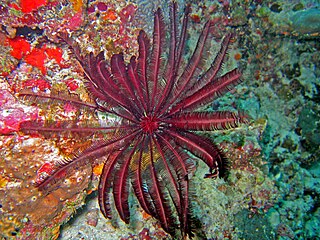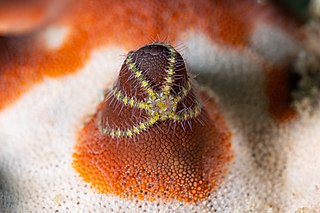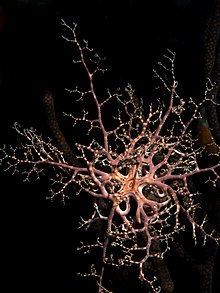
An echinoderm is any member of the phylum Echinodermata. The adults are recognisable by their radial symmetry, or pentamerous symmetry, and include starfish, brittle stars, sea urchins, sand dollars, and sea cucumbers, as well as the sea lilies or "stone lilies". Adult echinoderms are found on the sea bed at every ocean depth, from the intertidal zone to the abyssal zone. The phylum contains about 7,000 living species, making it the second-largest grouping of deuterostomes, after the chordates. Echinoderms are the largest entirely marine phylum. The first definitive echinoderms appeared near the start of the Cambrian.

Brittle stars, serpent stars, or ophiuroids are echinoderms in the class Ophiuroidea, closely related to starfish. They crawl across the sea floor using their flexible arms for locomotion. The ophiuroids generally have five long, slender, whip-like arms which may reach up to 60 cm (24 in) in length on the largest specimens.

Alcyonacea are an order of sessile colonial cnidarians that are found throughout the oceans of the world, especially in the deep sea, polar waters, tropics and subtropics. Whilst not in a strict taxonomic sense, Alcyonacea are commonly known as "soft corals" (Octocorallia) that are quite different from "true" corals (Scleractinia). The term “soft coral” generally applies to organisms in the two orders Pennatulacea and Alcyonacea with their polyps embedded within a fleshy mass of coenenchymal tissue. Consequently, the term “gorgonian coral” is commonly handed to multiple species in the order Alcyonacea that produce a mineralized skeletal axis composed of calcite and the proteinaceous material gorgonin only and corresponds to only one of several families within the formally accepted taxon Gorgoniidae (Scleractinia). These can be found in order Malacalcyonacea (taxonomic synonyms of include : Alcyoniina, Holaxonia, Protoalcyonaria, Scleraxonia, and Stolonifera. They are sessile colonial cnidarians that are found throughout the oceans of the world, especially in the deep sea, polar waters, tropics and subtropics. Common names for subsets of this order are sea fans and sea whips; others are similar to the sea pens of related order Pennatulacea. Individual tiny polyps form colonies that are normally erect, flattened, branching, and reminiscent of a fan. Others may be whiplike, bushy, or even encrusting. A colony can be several feet high and across, but only a few inches thick. They may be brightly coloured, often purple, red, or yellow. Photosynthetic gorgonians can be successfully kept in captive aquaria.
Ophiocanops fugiens is a living species in the brittle star family Ophiocanopidae. Though once considered to be the only one living species in this brittle star family, recent research has brought to light three specimens of Ophiocanops that differ substantially from O. fugiens. It has been regarded as the most primitive brittle star, close to Paleozoic forms, though other authors have disagreed with the view. Classification of O. fugiens is highly argued. Ophiocanops is usually placed in the order Oegophiurida or regarded as a genus incertae sedis or even given its own subclass Oegophiuridea. Some recent data suggest its relationship to the extant family Ophiomyxidae.

Millepora alcicornis, or sea ginger, is a species of colonial fire coral with a calcareous skeleton. It is found on shallow water coral reefs in the tropical west Atlantic Ocean. It shows a variety of different morphologies depending on its location. It feeds on plankton and derives part of its energy requirements from microalgae found within its tissues. It is an important member of the reef building community and subject to the same threats as other corals. It can cause painful stings to unwary divers.

Gorgonocephalus eucnemis is a species of basket star in the class Ophiuroidea. It is found in circumpolar marine environments in the Northern Hemisphere. The scientific name for the genus comes from the Greek, gorgós meaning "dreadful" and cephalus meaning "head", and refers to the similarity between these basket stars and the Gorgon's head from Greek mythology with its writhing serpents for hair. The specific name eucnemis is from the Greek "good" and "boot".

Ophiothrix suensoni, Suenson's brittle star or the sponge brittle star, is a species of marine invertebrate in the order Ophiurida. It is found in the Caribbean Sea and Gulf of Mexico. It is included in the subgenus Acanthophiothrix making its full scientific name Ophiothrix (Acanthophiothrix) suensoni.

Ophiocoma scolopendrina is a species of brittle star belonging to the family Ophiocomidae. Restricted to life in the intertidal, they live in the Indo-Pacific. They can typically be found within crevices or beneath borders on intertidal reef platforms. Unlike other Ophiocoma brittle stars, they are known for their unique way of surface-film feeding, using their arms to sweep the sea surface and trap food. Regeneration of their arms are a vital component of their physiology, allowing them to efficiently surface-film feed. These stars also have the ability to reproduce throughout the year, and have been known to have symbiotic relationships with other organisms.

Astroboa nuda is a type of basket star from Gorgonocephalidae family. Its large arms are highly branched. It inhabits reef slopes exposed to current in diverse places such as the Red Sea and New Caledonia. During the day it coils into a tight ball. At night it spreads arms to form a basket to feed on plankton. They are part of the class Ophiuroidea, which is the largest class of echinoderms. The name Ophiuroidea comes from the roots, ophis, meaning snake and oura, which means tail, referring to the thin, spiraling shape of the basket stars’ arms.

Gorgonocephalus arcticus is a species of basket star in the class Ophiuroidea. The genus name comes from the Greek, gorgós meaning "dreaded" and cephalus meaning "head", and refers to the similarity between these echinoids and the Gorgon's head from Greek myth with its coiled serpents for hair.

Amphiura chiajei is a species of brittle star belonging to the family Amphiuridae. It is found in the northeastern Atlantic Ocean and adjoining seas to a depth of 1,000 metres (3,300 ft). It digs itself into the soft sediment of the seabed and raises its arms into the water above to suspension feed on plankton. It was first described by the British naturalist Edward Forbes in 1843, and was named for the Italian zoologist Stefano Delle Chiaje (1794–1860).

Ophiocoma echinata, the spiny ophiocoma, is a species of brittle star belonging to the family Ophiocomidae. It is the type species of the genus Ophiocoma and is found in the tropical west Atlantic Ocean, the Caribbean Sea and the Gulf of Mexico.

Astrobrachion constrictum is a basket star in the family Euryalidae. It is mostly found at depths of between 50 and 180 m, but around the coast of New Zealand it occurs in shallow waters, in association with the black coral Antipathella fiordensis.

Astrobrachion adhaerens is a basket star in the Euryalidae family. Along with A. constrictum, it is one of only two species in the genus Astrobrachion. Both species live in association with soft corals in moderately deep water. It is endemic to the west, north and east coasts of Australia, the Kermadec Islands and Lord Howe Island.

Astrocladus euryale, the basket star, or gorgon's head is a brittlestar of the family Gorgonocephalidae found in the coastal waters of South Africa from the west coast of the Cape Peninsula to about Algoa Bay.

Echinaster luzonicus, the Luzon sea star, is a species of starfish in the family Echinasteridae, found in shallow parts of the western Indo-Pacific region. It sometimes lives symbiotically with a copepod or a comb jelly, and is prone to shed its arms, which then regenerate into new individuals.

Thyone fusus is a species of sea cucumber in the family Phyllophoridae. It is found on the seabed in the northeastern Atlantic Ocean and the Mediterranean Sea. It is a suspension feeder and catches food particles floating past with its branching feeding tentacles.

Paraleptopentacta elongata is a species of sea cucumber in the family Cucumariidae. It is found in the northeastern Atlantic Ocean and parts of the Mediterranean Sea. It is an infaunal species, occupying a burrow in the seabed, from which its anterior and posterior ends project.

Cenometra bella is a species of crinoids belonging to the genus Cenometra. They can have up to 30 arms and can be of variable colours but are often characterised by a marked contrast between the extending free-arms and the feathery pinnules. This species clings to its support and moves around by its feet-like cirri.

Ophiothela mirabilis is a species of ophiuroid brittle star within the family Ophiotrichidae. O. mirabilis is an epizoic species which have a non-parasitic relationship with host sponges or gorgonians. Although native to the Pacific Ocean, it has invaded the Caribbean and southwestern Atlantic since late 2000. Many of its characteristics, including reproduction and diet, allow O. mirabilis opportunities to quickly propagate and spread through habitats.



















